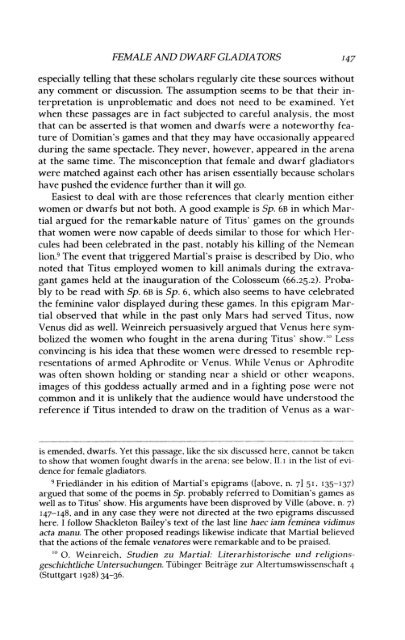OUSEION - Memorial University's Digital Archives Initiative ...
OUSEION - Memorial University's Digital Archives Initiative ...
OUSEION - Memorial University's Digital Archives Initiative ...
You also want an ePaper? Increase the reach of your titles
YUMPU automatically turns print PDFs into web optimized ePapers that Google loves.
FEMALE AND DWARF GLADIATORS 147<br />
especially telling that these scholars regularly cite these sources without<br />
any comment or discussion. The assumption seems to be that their interpretation<br />
is unproblematic and does not need to be examined. Yet<br />
when these passages are in fact subjected to careful analysis. the most<br />
that can be asserted is that women and dwarfs were a noteworthy feature<br />
of Domitian's games and that they may have occasionally appeared<br />
during the same spectacle. They never. however. appeared in the arena<br />
at the same time. The misconception that female and dwarf gladiators<br />
were matched against each other has arisen essentially because scholars<br />
have pushed the evidence further than it will go.<br />
Easiest to deal with are those references that clearly mention either<br />
women or dwarfs but not both. A good example is Sp. 68 in which Martial<br />
argued for the remarkable nature of Titus' games on the grounds<br />
that women were now capable of deeds similar to those for which Hercules<br />
had been celebrated in the past. notably his killing of the Nemean<br />
lion. 9 The event that triggered Martial's praise is described by Dio. who<br />
noted that Titus employed women to kill animals during the extravagant<br />
games held at the inauguration of the Colosseum (66.25.2). Probably<br />
to be read with Sp. 68 is Sp. 6. which also seems to have celebrated<br />
the feminine valor displayed during these games. In this epigram Martial<br />
observed that while in the past only Mars had served Titus. now<br />
Venus did as well. Weinreich persuasively argued that Venus here symbolized<br />
the women who fought in the arena during Titus' show. IO<br />
Less<br />
convincing is his idea that these women were dressed to resemble representations<br />
of armed Aphrodite or Venus. While Venus or Aphrodite<br />
was often shown holding or standing near a shield or other weapons.<br />
images of this goddess actually armed and in a fighting pose were not<br />
common and it is unlikely that the audience would have understood the<br />
reference if Titus intended to draw on the tradition of Venus as a war-<br />
is emended. dwarfs. Yet this passage. like the six discussed here. cannot be taken<br />
to show that women fought dwarfs in the arena; see below. 11.1 in the list of evidence<br />
for female gladiators.<br />
9 Friedlander in his edition of Martial's epigrams ([above. n. 7] 51. 135-137)<br />
argued that some of the poems in Sp. probably referred to Domitian's games as<br />
well as to Titus' show. His arguments have been disproved by Ville (above. n. 7)<br />
147-148. and in any case they were not directed at the two epigrams discussed<br />
here. I follow Shackleton Bailey's text of the last line haec iam feminea vidimus<br />
acta manu. The other proposed readings likewise indicate that Martial believed<br />
that the actions of the female venatores were remarkable and to be praised.<br />
10 O. Weinreich. Studien zu Martial: Literarhistorische und reJigionsgeschichtliche<br />
Untersuchungen. Tiibinger Beitrage zur Altertumswissenschaft 4<br />
(Stuttgart 1928) 34-36.

















